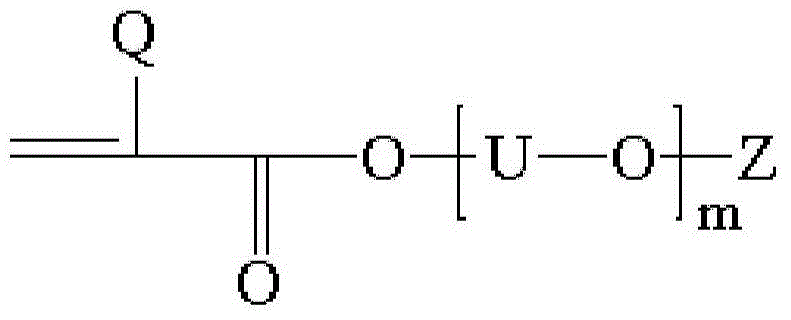Pressure-sensitive adhesive composition
A technology of pressure-sensitive adhesives and compositions, applied in the direction of adhesive types, conductive adhesives, ester copolymer adhesives, etc., can solve problems such as difficult to suppress static electricity, strength reduction, pollution, etc.
- Summary
- Abstract
- Description
- Claims
- Application Information
AI Technical Summary
Problems solved by technology
Method used
Image
Examples
preparation example 1
[0158] Preparation example 1: the preparation of acrylic acid (ester) polymer A
[0159] 80 parts by weight of 2-ethylhexyl acrylate (2-EHA), 2 parts by weight of 4-hydroxybutyl acrylate (4-HBA), 8 parts by weight of 2-hydroxyethyl acrylate (2-HEA) and 10 parts by weight of polyethylene glycol monomethyl ether methacrylate (the molar number of oxyethylene units added: 9 mol) were added to a 1L reactor equipped with a cooling device that was easy to carry out nitrogen reflux and easy to adjust the temperature, 100 parts by weight of ethyl acetate was added as a solvent. Subsequently, the reactor was purged with nitrogen for 1 hour to remove oxygen, a reaction initiator (AIBN: azobisisobutyronitrile) was added, reacted for about 8 hours, and the reaction product was diluted with ethyl acetate to obtain acrylic acid (ester) class copolymer A. Copolymer A had a viscosity of about 2500 cP and a solids content of about 45%.
preparation example 2-10
[0160] Preparation example 2-10. Preparation of acrylic acid (ester) copolymer B-J
[0161] An acrylic (ester)-based copolymer was prepared in the same manner as described in Preparation Example 1, except that the proportion of monomers used to prepare the copolymer was changed as shown in Table 1 and Table 2.
[0162] Table 1
[0163]
[0164] Table 2
[0165]
Embodiment 1-10 and comparative example 1-5
[0167] Tinuvin-144, Tinuvin-765, Irganox 1010 or Irganox 2450 are mixed with each kind of acrylic (ester) copolymer prepared in the preparation example according to the proportion listed in Table 3 and 4 respectively (relative to 100 parts by weight described Acrylic (ester) copolymer). Each mixture was placed in an oven set at 45° C. for 28 days, after which the transparency, viscosity retention and solids content of the copolymers were observed. After storing the copolymers as described above, the clarity of the polymers was determined by visual inspection of the polymers. In this case, when the copolymer is transparent, it is marked as "A", and when fogging is observed due to the presence of crystalline foreign matter, it is marked as "B". The results of the determination of the respective acrylic copolymers are summarized in Tables 5 and 6.
[0168] table 3
[0169]
[0170] Table 4
[0171]
[0172] table 5
[0173]
[0174] Table 6
[0175]
PUM
| Property | Measurement | Unit |
|---|---|---|
| thickness | aaaaa | aaaaa |
| particle size | aaaaa | aaaaa |
| degree of polymerization | aaaaa | aaaaa |
Abstract
Description
Claims
Application Information
 Login to View More
Login to View More - R&D
- Intellectual Property
- Life Sciences
- Materials
- Tech Scout
- Unparalleled Data Quality
- Higher Quality Content
- 60% Fewer Hallucinations
Browse by: Latest US Patents, China's latest patents, Technical Efficacy Thesaurus, Application Domain, Technology Topic, Popular Technical Reports.
© 2025 PatSnap. All rights reserved.Legal|Privacy policy|Modern Slavery Act Transparency Statement|Sitemap|About US| Contact US: help@patsnap.com



